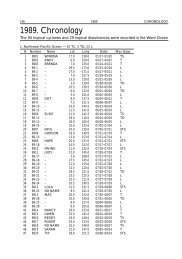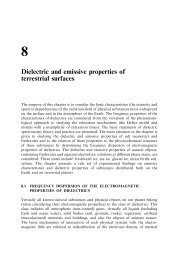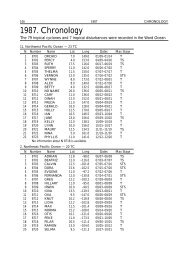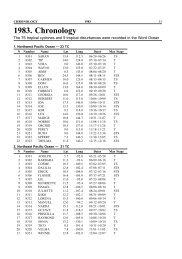Программа и тезисы докладов - Институт космических ...
Программа и тезисы докладов - Институт космических ...
Программа и тезисы докладов - Институт космических ...
Create successful ePaper yourself
Turn your PDF publications into a flip-book with our unique Google optimized e-Paper software.
The initial assessment of the electromagnetic equipment quality is performed<br />
and the reasons for insufficient information content of current measurement channels<br />
are discussed. We also present the examples of ionosphere whistlers detected<br />
over the areas with thunder activity.<br />
lighTning diScharge radio eMiSSion according<br />
To The daTa FroM radioFrequency analyzer<br />
V. M. Gotlib, V. N. Karedin, M. S. Dolgonosov<br />
Space Research Institute of Russian Academy of Russian, IKI RAN, Moscow, Russia<br />
The report includes a block diagram of radiofrequency analyzer, basic device<br />
parameters, the peculiarities of reception, relating to technogeneous disturbance,<br />
and, besides, the description of chosen zones and time of lightning activity observations.<br />
We also present the data on the device functioning statistics and typical examples<br />
of lightning activity under observation (wave functions and spectrograms).<br />
Apart from that, the parameters of lightning discharges are evaluated and possible<br />
ways of radiofrequency measuring modernization are discussed.<br />
Fine radio eMiSSion STrucTure oF high-alTiTude<br />
ThunderSTorM ForMaTionS according To “chibiS-M”<br />
M. S. Dolgonosov, V. M. Gotlib<br />
Space Research Institute of Russian Academy of Russian, IKI RAN, Moscow, Russia<br />
Micro-satellite “Chibis-M” was sent into orbit in the beginning of 2012. The<br />
satellite is intended for the complex investigation of processes taking place within a<br />
thunderstorm cloud. This report comprises the results of lightning activity analysis<br />
based on radio emission (in the range of 26…68 MHz) data, provided by the radiofrequency<br />
analyzer. The main issues we are meaning to cover in the report are as<br />
follows: the classification of detected events and their characteristics, the assessment<br />
of the electric discharge altitude above the Earth’s surface, the explanation of lightning<br />
radio pulse discrete nature and, besides, the estimation of step leader motion.<br />
As we see it, the presented microsecond impulse characteristics can be associated<br />
with the fractal model of charge distribution within a thunderstorm area, described<br />
in Hayakawa et al., JASTP, 2008. In order to check this hypothesis we will present<br />
a comparative analysis of topological dimensions of microsecond impulses, taken<br />
with the use of both “Chibis-M” and the theoretical model from Hayakawa et al.,<br />
JASTP, 2008.<br />
29

















